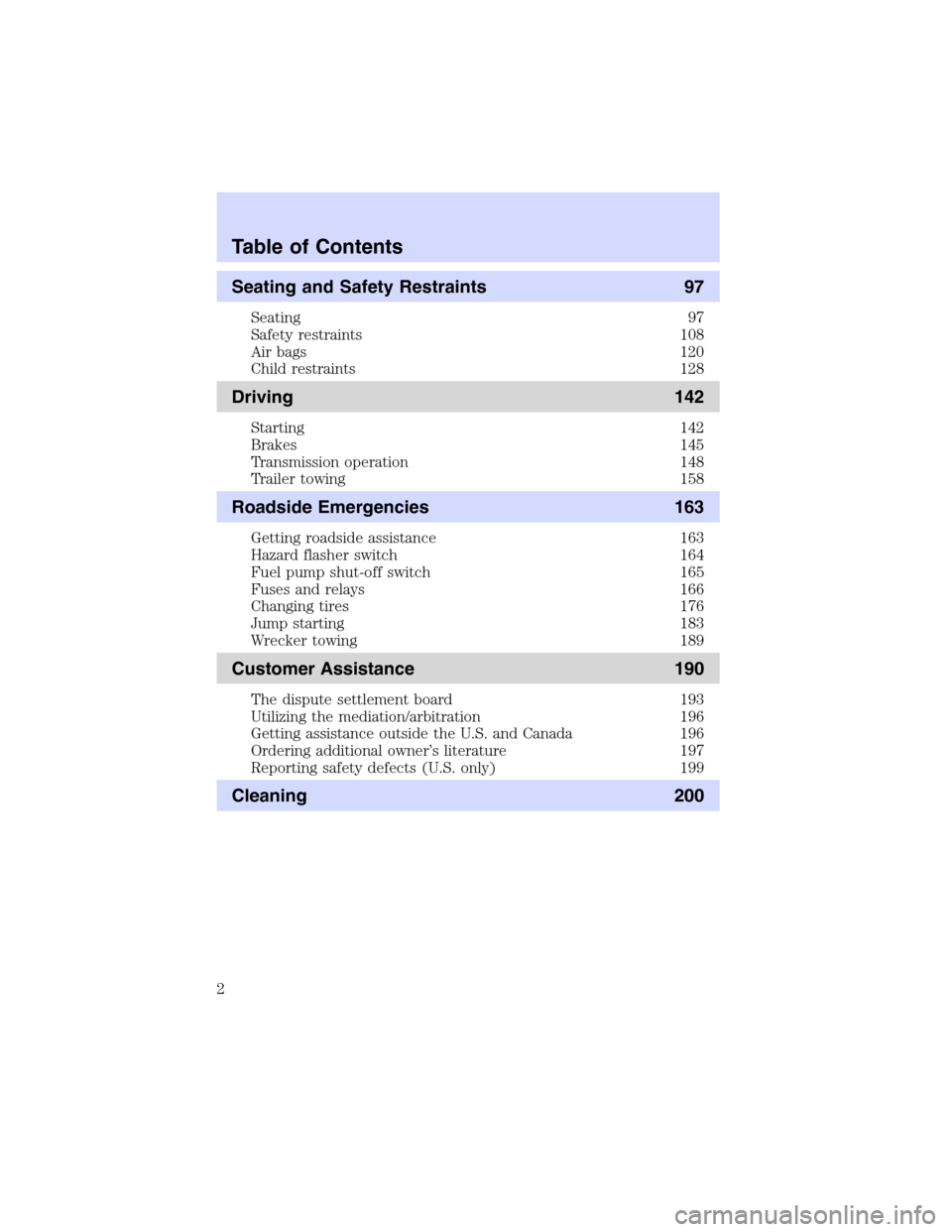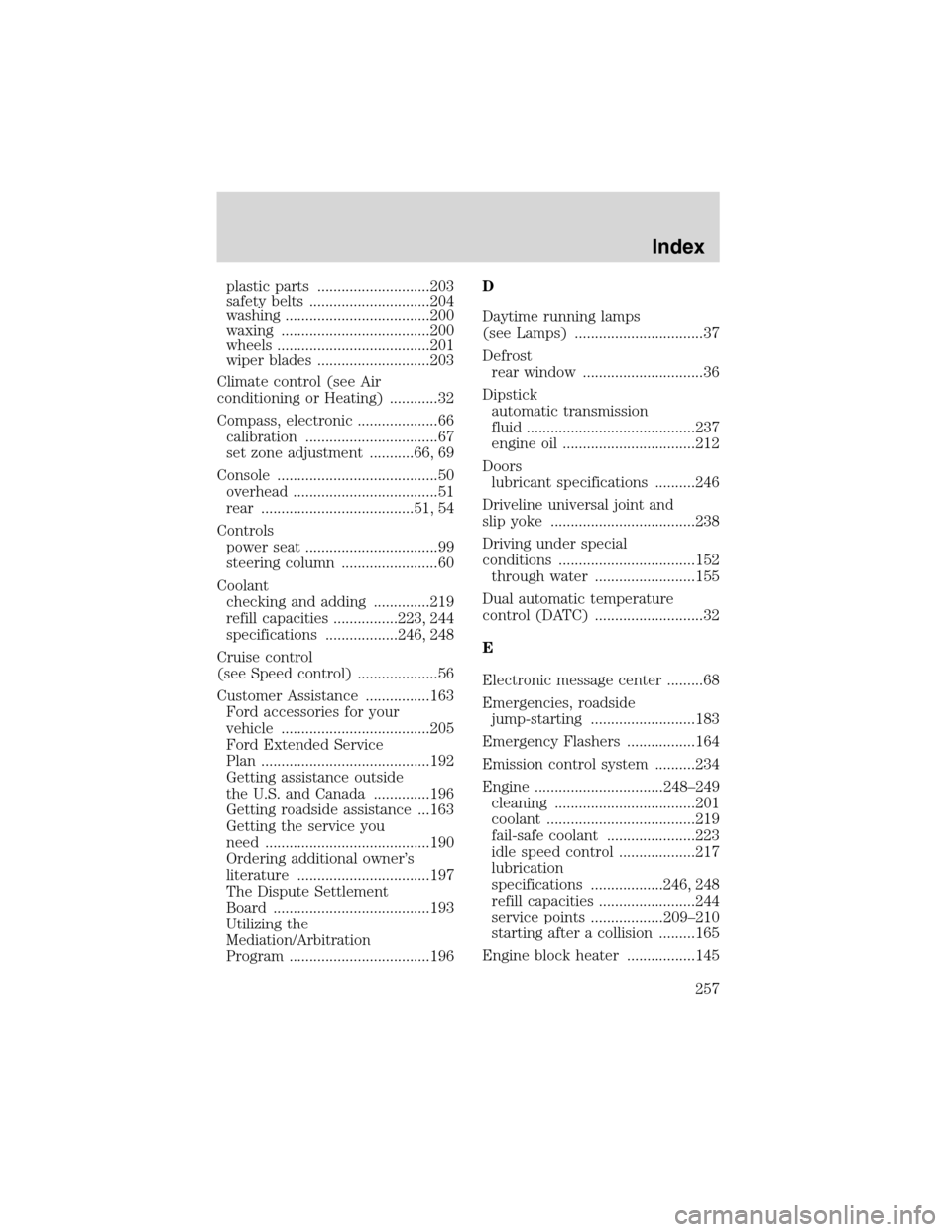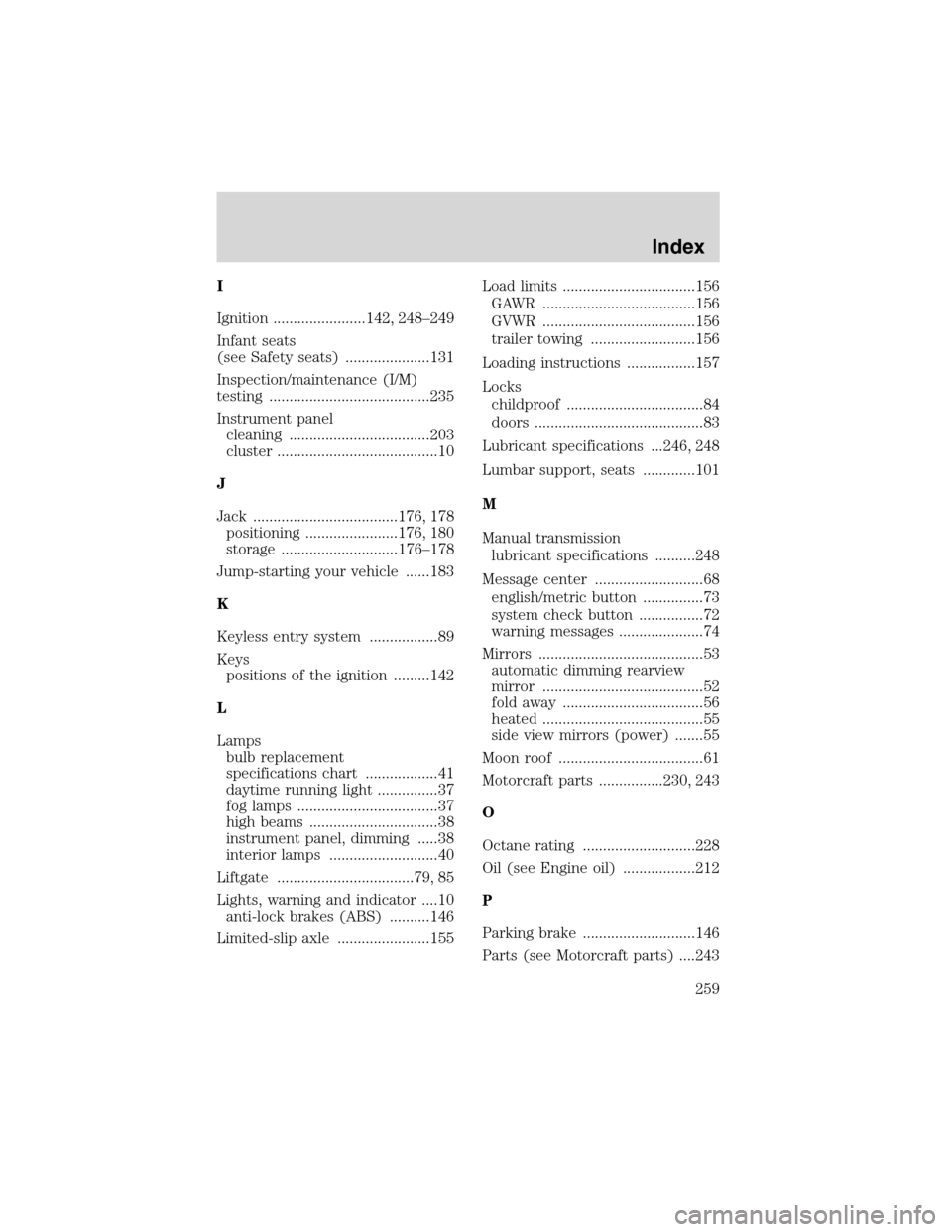jump start Mercury Mountaineer 2003 Owner's Manuals
[x] Cancel search | Manufacturer: MERCURY, Model Year: 2003, Model line: Mountaineer, Model: Mercury Mountaineer 2003Pages: 264, PDF Size: 2.5 MB
Page 2 of 264

Seating and Safety Restraints 97
Seating 97
Safety restraints 108
Air bags 120
Child restraints 128
Driving 142
Starting 142
Brakes 145
Transmission operation 148
Trailer towing 158
Roadside Emergencies 163
Getting roadside assistance 163
Hazard flasher switch 164
Fuel pump shut-off switch 165
Fuses and relays 166
Changing tires 176
Jump starting 183
Wrecker towing 189
Customer Assistance 190
The dispute settlement board 193
Utilizing the mediation/arbitration 196
Getting assistance outside the U.S. and Canada 196
Ordering additional owner’s literature 197
Reporting safety defects (U.S. only) 199
Cleaning 200
Table of Contents
2
Page 163 of 264

GETTING ROADSIDE ASSISTANCE
To fully assist you should you have a vehicle concern, Ford Motor
Company offers a complimentary roadside assistance program. This
program is separate from the New Vehicle Limited Warranty. The service
is available:
•24–hours, seven days a week
•for the New Vehicle Limited Warranty period of three years or 60,000
km (36,000 miles), whichever occurs first on Ford and Mercury
vehicles, and four years or 80,000 km (50,000 miles) on Lincoln
vehicles.
Roadside assistance will cover:
•changing a flat tire
•jump-starts
•lock-out assistance
•limited fuel delivery
•towing of your disabled vehicle to the nearest Ford Motor Company
dealership, or your selling dealer if within 56.3 km (35 miles) of the
nearest Ford Motor Company dealership (one tow per disablement).
Even non-warranty related tows, like accidents or getting stuck in the
mud or snow, are covered (some exclusions apply, such as impound
towing or repossession).
Canadian customers refer to your Owner Information Guide for
information on:
•coverage period
•exact fuel amounts
•towing of your disabled vehicle
•emergency travel expense reimbursement
•travel planning benefits
Roadside Emergencies
Roadside Emergencies
163
Page 183 of 264

ability, to the point where the ratchet/slip occurs, if possible. The spare
tire carrier will not allow you to overtighten. If the spare tire carrier
ratchets or slips with little effort, take the vehicle to your dealer for
assistance at your earliest convenience.
4. Check that the tire lies flat against the frame and is properly
tightened. Try to push or pull, then turn the tire to be sure it will not
move. Loosen and retighten, if necessary. Failure to properly stow the
spare tire may result in failure of the winch cable and loss of the tire.
5. If your vehicle is equipped with a spare tire lock and key, be sure to
install the spare tire lock into the bumper drive tube with the spare tire
lock key and jack handle.
6. Repeat this tightness check procedure when servicing the spare tire
pressure (every six months, per scheduled maintenance guide), or at any
time that the spare tire is disturbed through service of other
components.
Re-stowing the jack and tools
1. Unblock the wheels.
2. Replace beauty cap, stow the jack and tools in their respective
locations, making sure they are fully secured so they do not rattle when
you drive.
JUMP STARTING YOUR VEHICLE
The gases around the battery can explode if exposed to flames,
sparks, or lit cigarettes. An explosion could result in injury or
vehicle damage.
Batteries contain sulfuric acid which can burn skin, eyes and
clothing, if contacted.
Do not attempt to push-start your vehicle. Automatic
transmissions do not have push-start capability; also, the
catalytic converter may become damaged.
Roadside Emergencies
183
Page 184 of 264

Preparing your vehicle
When the battery is disconnected or a new battery is installed, the
transmission must relearn its shift strategy. As a result, the transmission
may have firm and/or soft shifts. This operation is considered normal and
will not affect function or durability of the transmission. Over time, the
adaptive learning process will fully update transmission operation.
1.Use only a 12–volt supply to start your vehicle.
2. Do not disconnect the battery of the disabled vehicle as this could
damage the vehicle’s electrical system.
3. Park the booster vehicle close to the hood of the disabled vehicle
making sure the two vehiclesdo nottouch. Set the parking brake on
both vehicles and stay clear of the engine cooling fan and other moving
parts.
4. Check all battery terminals and remove any excessive corrosion before
you attach the battery cables. Ensure that vent caps are tight and level.
5. Turn the heater fan on in both vehicles to protect any electrical
surges. Turn all other accessories off.
Connecting the jumper cables
1. Connect the positive (+) jumper cable to the positive (+) terminal of
the discharged battery.
Note:In the illustrations,lightning boltsare used to designate the
assisting (boosting) battery.
+–+–
Roadside Emergencies
184
Page 185 of 264

2. Connect the other end of the positive (+) cable to the positive (+)
terminal of the assisting battery.
3. Connect the negative (-) cable to the negative (-) terminal of the
assisting battery.
4. Make the final connection of the negative (-) cable to the provided
jumpstarting bolt.
Do notuse fuel lines, engine rocker covers or the intake manifold as
groundingpoints.
Do not connect the end of the second cable to the negative (-)
terminal of the battery to be jumped. A spark may cause an
explosion of the gases that surround the battery.
+–+–
+–+–
Roadside Emergencies
185
Page 187 of 264

5. Ensure that the cables are clear of fan blades, belts, moving parts of
both engines, or any fuel delivery system parts.
Jump starting
1. Start the engine of the booster vehicle and run the engine at
moderately increased speed.
2. Start the engine of the disabled vehicle.
3. Once the disabled vehicle has been started, run both engines for an
additional three minutes before disconnecting the jumper cables.
Removing the jumper cables
Remove the jumper cables in the reverse order that they were
connected.
1. Remove the jumper cable from thegroundmetal surface.
2. Remove the jumper cable on the negative (-) connection of the
booster vehicle’s battery.
+–+–
Roadside Emergencies
187
Page 188 of 264

3. Remove the jumper cable from the positive (+) terminal of the booster
vehicle’s battery.
4. Remove the jumper cable from the positive (+) terminal of the
disabled vehicle’s battery.
After the disabled vehicle has been started and the jumper cables
removed, allow it to idle for several minutes so the engine computer can
relearn its idle conditions.
+–+–
+–+–
Roadside Emergencies
188
Page 257 of 264

plastic parts ............................203
safety belts ..............................204
washing ....................................200
waxing .....................................200
wheels ......................................201
wiper blades ............................203
Climate control (see Air
conditioning or Heating) ............32
Compass, electronic ....................66
calibration .................................67
set zone adjustment ...........66, 69
Console ........................................50
overhead ....................................51
rear ......................................51, 54
Controls
power seat .................................99
steering column ........................60
Coolant
checking and adding ..............219
refill capacities ................223, 244
specifications ..................246, 248
Cruise control
(see Speed control) ....................56
Customer Assistance ................163
Ford accessories for your
vehicle .....................................205
Ford Extended Service
Plan ..........................................192
Getting assistance outside
the U.S. and Canada ..............196
Getting roadside assistance ...163
Getting the service you
need .........................................190
Ordering additional owner’s
literature .................................197
The Dispute Settlement
Board .......................................193
Utilizing the
Mediation/Arbitration
Program ...................................196D
Daytime running lamps
(see Lamps) ................................37
Defrost
rear window ..............................36
Dipstick
automatic transmission
fluid ..........................................237
engine oil .................................212
Doors
lubricant specifications ..........246
Driveline universal joint and
slip yoke ....................................238
Driving under special
conditions ..................................152
through water .........................155
Dual automatic temperature
control (DATC) ...........................32
E
Electronic message center .........68
Emergencies, roadside
jump-starting ..........................183
Emergency Flashers .................164
Emission control system ..........234
Engine ................................248–249
cleaning ...................................201
coolant .....................................219
fail-safe coolant ......................223
idle speed control ...................217
lubrication
specifications ..................246, 248
refill capacities ........................244
service points ..................209–210
starting after a collision .........165
Engine block heater .................145
Index
257
Page 259 of 264

I
Ignition .......................142, 248–249
Infant seats
(see Safety seats) .....................131
Inspection/maintenance (I/M)
testing ........................................235
Instrument panel
cleaning ...................................203
cluster ........................................10
J
Jack ....................................176, 178
positioning .......................176, 180
storage .............................176–178
Jump-starting your vehicle ......183
K
Keyless entry system .................89
Keys
positions of the ignition .........142
L
Lamps
bulb replacement
specifications chart ..................41
daytime running light ...............37
fog lamps ...................................37
high beams ................................38
instrument panel, dimming .....38
interior lamps ...........................40
Liftgate ..................................79, 85
Lights, warning and indicator ....10
anti-lock brakes (ABS) ..........146
Limited-slip axle .......................155Load limits .................................156
GAWR ......................................156
GVWR ......................................156
trailer towing ..........................156
Loading instructions .................157
Locks
childproof ..................................84
doors ..........................................83
Lubricant specifications ...246, 248
Lumbar support, seats .............101
M
Manual transmission
lubricant specifications ..........248
Message center ...........................68
english/metric button ...............73
system check button ................72
warning messages .....................74
Mirrors .........................................53
automatic dimming rearview
mirror ........................................52
fold away ...................................56
heated ........................................55
side view mirrors (power) .......55
Moon roof ....................................61
Motorcraft parts ................230, 243
O
Octane rating ............................228
Oil (see Engine oil) ..................212
P
Parking brake ............................146
Parts (see Motorcraft parts) ....243
Index
259
Page 260 of 264

Pedals (see Power adjustable
foot pedals) .................................56
Power adjustable foot pedals .....56
Power distribution box
(see Fuses) ...............................171
Power door locks ........................83
Power point .....................51, 53–54
Power steering ..........................147
fluid, checking and adding ....236
fluid, refill capacity ................244
fluid, specifications .........246, 248
Power Windows ...........................54
Preparing to drive your
vehicle ........................................148
R
Radio ................................17, 21, 25
Rear window defroster ...............36
Relays ................................166, 174
Remote entry system .................85
illuminated entry ......................88
locking/unlocking doors ...........95
opening the trunk .....................85
Reverse sensing system ...........153
Roadside assistance ..................163
Roof rack .....................................81
S
Safety Belt Maintenance ..........119
Safety belts (see Safety
restraints) ..........108, 110–113, 115
Safety Canopy ...................124, 126
Safety defects, reporting ..........199
Safety restraints ........108, 110–115belt minder .............................116
extension assembly ................115
for adults .........................111–113
for children .....................128–129
safety belt maintenance .........119
warning light and
chime ...............................115–116
Safety seats for children ..........131
Seat belts
(see Safety restraints) .............108
Seats ............................................97
child safety seats ....................131
heated ......................................101
memory seat .....................86, 100
Snowplowing .................................7
Spark plugs,
specifications .............243, 248–249
Special notice
ambulance conversions ..............7
utility-type vehicles ....................7
Specification chart,
lubricants ...........................246, 248
Speed control ..............................56
Starting a flex fuel vehicle .......144
Starting your vehicle ........142, 144
jump starting ..........................183
Steering wheel
controls ......................................60
tilting .........................................49
T
Tilt steering wheel ......................49
Tire warning ..............................242
Tires ...........................176, 239, 242
changing ..........................176, 180
replacing ..................................180
snow tires and chains ............243
Index
260